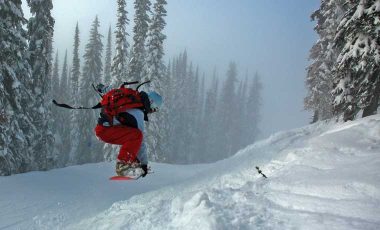If you’re about to go on your first trip to the slopes, you’ll need to know what to wear skiing and snowboarding. Getting your clothing right will help keep you warm, dry, and protected from the elements, which in turn will mean you have an even better time.
In this article I’m going to make some suggestions on what to wear skiing and snowboarding, including what I wear when I snowboard. You’ll also find information on what sort of fabrics to look for and their properties.
- What to wear skiing and snowboarding
- Other ski and snowboard clothing items that you need
- What to look for when choosing clothing for skiing and snowboarding
Disclaimer: We use affiliate links and may receive a small commission on purchases.
What to wear skiing and snowboarding

Underpants
Properties: Moisture wicking, quick drying, odor resistant, flat seams
Fabric: Merino, synthetic or Polygiene treated synthetic
What I wear: Runderwear Women’s Briefs
Other great options: Our favourite active underwear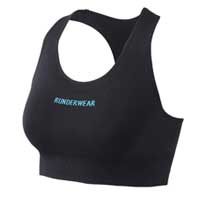
Sports bra
Properties: Moisture wicking, quick drying, odor resistant, flat seams
Fabric: Merino, synthetic or Polygiene treated synthetic
What I wear: Runderwear Low-Impact Crop Top
Other great options: Our favourite active underwear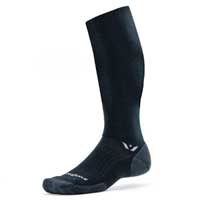
Ski socks
Properties: Warm, moisture wicking, odor resistant
Fabric: Merino/synthetic blend, or Polygiene treated synthetic
What I wear: Swiftwick Pursuit Twelve Socks
Other features: Ski and snowboard socks should be long enough to fit underneath your boots — ideally coming up just below the knee.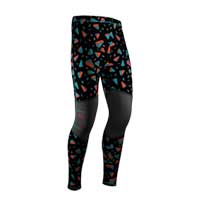
Long Johns
Properties: Moisture wicking, odor resistant, quick drying
Fabric: Merino, synthetic or Polygiene treated synthetic
What I wear: So Solid Tights
Other info: Depending on the conditions, long johns aren’t always necessary, especially if your ski pants are lightly insulated.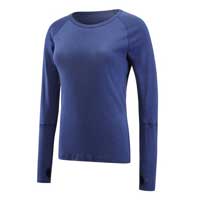
Base layer top
Properties: Moisture wicking, odor resistant, quick drying
Fabric: Merino, synthetic or Polygiene treated synthetic
What I wear: Armadillo Merino Artemis Women’s Long Sleeve Crew Neck
Other great options: Base layers for skiing and snowboarding
Mid layer
Properties: Insulating, Breathable, waterproof, durable, lightweight
Fabric: Leather, synthetic or a mix of both
What I wear: Mountain Hardwear Monkey Woman Grid Hooded Jacket
More info and options: Mid layers for skiing and snowboarding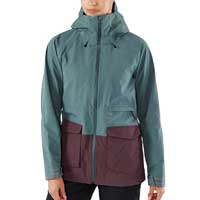
Ski jacket
Properties: Waterproof, breathable, durable, lightly insulated
Fabric: Synthetic
Other features: Many ski jackets have an internal snow skirt that helps prevent snow from getting underneath your jacket when you fall over. They also often feature a ski pass holder and pit vents. Ski jackets can range from being highly insulated to having no insulation at all.
What I wear: Dakine Women’s Remington Pure 2l Jacket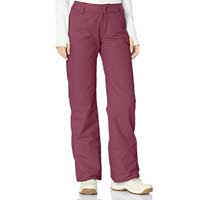
Ski pants
Properties: Waterproof, windproof, breathable, durable, lightly insulated
Fabric: Synthetic
Other features: Some ski pants have zippered vents to help regulate your temperature. They are usually lightly insulated or have no insulation at all, but they are usually lined.
What I wear: Volcom Women’s Frochickie Insulated Lined Snow Pant
Ski gloves
Properties: Warm, breathable, waterproof, windproof, durable
Fabric: Leather or synthetic with down or synthetic insulation
Other features: A nose wipe is always good, as well as the ability to clip them together.
What I wear: Sealskinz Waterproof Extreme Cold Weather Down Mitten
Beanie hat or buff
Properties: Warm, moisture wicking, quick drying
Fabric: Merino, polyester fleece or synthetic
Other info: Your hat or buff should be thin enough to fit underneath a helmet without causing excess pressure on your head. But it needs enough insulation to keep you warm when not moving.
What I wear: Merino Buff
Other ski and snowboard clothing that you need
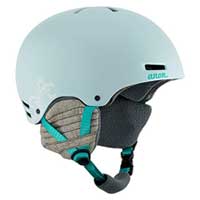
Helmet
Ski and snowboard helmets should provide warmth and padding, as well as protection. Some have a small peak at the front and a goggle clip at the back. Most helmets have removable ear pads.
What I wear: Anon Greta Helmet
More info and options: Helmets for skiing and snowboarding
Goggles
Goggles with mirrored lenses are best for sunny, bright days. But on low, flat light days you will need more of an orange/brown lens. Goggles with interchangeable are the ideal solution if the conditions are variable.
What I wear: Panda Optics RS1 Magnetic Goggles
More info and options: Goggles for skiing and snowboarding
What to look for when choosing clothing for skiing and snowboarding
Getting your layering systems right can be tricky at the best of times. On the ski slopes it’s even trickier! One minute you’re huddling together on the ski lift enduring sub-zero temperatures, plus wind-chill. The next minute you’re charging downhill in the blazing sun, pushing every muscle in your body to its limit. Wearing clothing that deals with all of this without catching hypothermia or sweating buckets takes come fine-tuning.
To help you figure out what you need out of your clothing for snowboarding and skiing, take a read of the below pointers:
01Fit
Whether you like it or not, ski and snowboard clothing has always been lead by style and fashion, as much as practicality and functionality. So the fit of the clothing you choose for snowboarding and skiing can largely depend on your style.
However, if style isn’t the most important thing to you and you prefer to be comfortable in clothing that functions as it should and protects you from the elements, then here’s our fitting guide.
General fit of skiing and snowboarding clothes:
- Outer layers should be loose-fitting — they shouldn’t cause any kind of restriction during movement. Some people opt for super baggy outer layers. This is totally fine so long as the excess fabric doesn’t cause restriction, or doesn’t become too heavy when wet.
- Mid layers should be fitted but not tight — if they are too baggy they may cause a draft and create excess bulk underneath your outer layers. Too tight and they will cause restriction in movement.
- Base layers should be close-fitting — ensure that you get the right size for you, otherwise their close fit can cause restriction or chaffing. Base layer tops should also be long enough to tuck into your long johns or outer pants to prevent a draft at your midriff.
- All clothing for skiers and snowboarders should be the right size — pants that are too big at the waist can ride up, as can pants that are too small! Equally, layers that are ill-fitting can create gathering of excess fabric which can result in chaffing and discomfort.
Get the fit right and you’re halfway there to a highly comfortable set of clothing to hit the slopes in.
02Fabric
Once you’ve got the fit right, the next most important thing to consider is the fabric of your ski and snowboard clothes. This can be a little more complex…
Each item of clothing you choose and need has a specific job to do, mostly determined by the fabric with which they are made.
The jobs of ski and snowboard clothes fabrics include:
- Temperature control – keeping you warm when you’re sitting on the ski lift, but not so warm that you overheat when charging down the slopes on your skis or snowboard.
- Moisture wicking – moving moisture (sweat) away from your skin. Base layers are great at this.
- Quick drying
- Odour control – preventing the buildup of bacteria on your clothes
- Breathability – allows moisture vapour and air to move through the fabric.
- Waterproofing – preventing water from getting inside your clothing.
- Windproofing – stopping the wind from penetrating your clothing
Each of the above jobs, when done properly, contribute to the overall comfort of your clothes for skiing and snowboarding.
03Types of fabric for ski and snowboard clothes
Synthetic fabrics (polyester, nylon or blends)
Good at: Drying quickly, moisture wicking, not holding water
Bad at: Odour control, providing warmth when wetMerino wool
Good at: Moisture wicking, odour control, temperature regulation, providing warmth when wet, breathability
Bad at: Drying quickly, rinsing your bank account!Goose down
Good at: Keeping you really warm, packing down small, breathability
Bad at: Providing warmth when wet, waterproofing, drying quicklyPolyester fleece
Good at: Drying quickly, moisture wicking, not holding water
Bad at: Odour resistance
04Clothing technologies
Gore-tex
This is a brand of semi-permeable fabric. It is a waterproof and breathable membrane that is added to clothing or footwear, and repels water but allows air and water vapour (sweat) to move in and out.
Polygiene
Polygiene odour control technology prevents odour-causing bacteria from growing on your clothing. Fabric is treated with silver salt which has antimicrobial properties.
You could spend a fortune on all the latest clothing and gear. But for the first couple of trips this isn’t totally necessary, so long as you are warm and dry. The more you do it, however, the more you will start to learn what to wear skiing and snowboaring in specific conditions, locations and scenarios. Then you can start fine-tuning your clothing choices.
Whatever ski and snowboarding clothes you do end up choosing, make sure they’re comfortable, warm and protective and you’ll be good to go!


